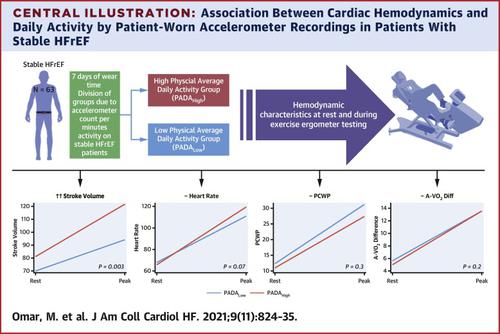JACC: Heart Failure ( IF 10.3 ) Pub Date : 2021-09-08 , DOI: 10.1016/j.jchf.2021.05.013 Massar Omar 1 , Jesper Jensen 2 , Peter H Frederiksen 3 , Lars Videbæk 4 , Mikael Kjær Poulsen 4 , Jan Christian Brønd 5 , Finn Gustafsson 6 , Barry A Borlaug 7 , Morten Schou 2 , Jacob Eifer Møller 8

|
Objectives
This study examined the link between accelerometer recordings and cardiac pathophysiology measured with right heart cauterization at rest and with exercise in patients with HFrEF.
Background
Patient-worn accelerometers are increasingly being used in patients with heart failure with reduced ejection fraction (HFrEF) to assess activity and serve as surrogate endpoints in heart failure trials.
Methods
Physical average daily activity (PADA) and total average daily activity according to accelerometer units were assessed in 63 patients (mean age 58 ± 10 years; mean ejection fraction 26% ± 4%). Patients underwent hemodynamic exercise testing and accelerometry. Patients were divided according to PADA in PADALow and PADAHigh activity level groups based on median counts per minute of physical activity.
Results
Patients in the PADALow group were older and more frequently treated with diuretics. At rest, the PADALow group was characterized by a lower cardiac index (2.2 ± 0.4 L/min/m2 vs 2.4 ± 0.4 L/min/m2; P = 0.01) and stroke volume (70 ± 19 mL vs 81 ± 17 mL; P = 0.02) but not pulmonary capillary wedge pressure (12 ± 5 mm Hg vs 11 ± 5 mm Hg; P = 0.3). The PADALow group reached a lower cardiac index (4.8 ± 1.7 L/min/m2 vs 6.6 ± 1.7 L/min/m2; P < 0.001) but not in pulmonary capillary wedge pressure (31 ± 12 mm Hg vs 27 ± 8 mm Hg; P = 0.2) at peak exercise. The attenuated increase was associated with an attenuated increase in stroke volume (94 ± 32 mL vs 121 ± 29 mL; P < 0.001) rather than a reduced increase in heart rate (42 ± 23 beats/min vs 52 ± 21 beats/min; P = 0.07). PADA and total average daily accelerometer units were associated with patient-reported functional impairment according to the Kansas City Cardiomyopathy Questionnaire but not with New York Heart Association functional class.
Conclusions
Among stable ambulatory patients with HFrEF, lower daily activity is associated with poorer cardiac index reserve and reduced cardiac index during exercise. (Empagliflozin in Heart Failure Patients With Reduced Ejection Fraction; NCT03198585)
中文翻译:

稳定型心力衰竭患者加速度计测量活动的血流动力学决定因素
目标
这项研究检查了加速度计记录与心脏病理生理学之间的联系,这些病理生理学是在 HFrEF 患者的休息时右心烧灼和运动时测量的。
背景
患者佩戴的加速度计越来越多地用于射血分数降低 (HFrEF) 的心力衰竭患者,以评估活动并作为心力衰竭试验的替代终点。
方法
在 63 名患者(平均年龄 58 ± 10 岁;平均射血分数 26% ± 4%)中评估了根据加速度计单位的身体平均每日活动 (PADA) 和总平均每日活动。患者接受了血流动力学运动测试和加速度计。根据 PADA低和 PADA高活动水平组中的 PADA 将患者分为基于每分钟身体活动的中位数计数。
结果
PADA Low组的患者年龄较大,并且更频繁地接受利尿剂治疗。静息时,低PADA组的特点是心脏指数较低(2.2 ± 0.4 L/min/m 2对比 2.4 ± 0.4 L/min/m 2;P = 0.01)和每搏输出量(70 ± 19 mL vs 81 ± 17 mL;P = 0.02)但不是肺毛细血管楔压(12 ± 5 mm Hg vs 11 ± 5 mm Hg;P = 0.3)。PADA Low组的心脏指数较低(4.8 ± 1.7 L/min/m 2对比 6.6 ± 1.7 L/min/m 2;P < 0.001),但肺毛细血管楔压未达到(31 ± 12 mm Hg vs 27 ± 8 毫米汞柱;P =0.2) 在运动高峰期。减弱的增加与每搏输出量的减弱增加有关(94 ± 32 mL vs 121 ± 29 mL;P < 0.001)而不是心率增加的减少(42 ± 23 次/分钟 vs 52 ± 21 次/分钟;P = 0.07)。根据堪萨斯城心肌病问卷调查,PADA 和总平均每日加速度计单位与患者报告的功能障碍相关,但与纽约心脏协会功能等级无关。
结论
在 HFrEF 稳定的非卧床患者中,较低的日常活动与较差的心脏指数储备和运动期间的心脏指数降低有关。(Empagliflozin 用于射血分数降低的心力衰竭患者;NCT03198585)









































 京公网安备 11010802027423号
京公网安备 11010802027423号